Is Work-Life Balance Actually Possible When You Own a Business?
Starting a business brings a lot of responsibilities and tasks that can quickly eat up your time. If you’re starting a business while also balancing home and family time, or a full-time job, it may seem impossible to get any true work-life balance.
Is it possible? Can you achieve work-life balance while owning and running a business?
Yes! It takes some changes to how you approach work, but you can make it happen! Here’s how.
Reflect on the Big Picture
If you’re struggling with your work-life balance, or lack thereof, the first step is to give yourself some distance and reflect on the big picture.
For many business owners, this reflection only happens when something significant happens, such as a death or the birth of a child, but it doesn’t have to take such a big upheaval.
Consider your sources of stress or dissatisfaction. How are the circumstances affecting your performance? Your happiness with your work or personal life? How are your priorities? What are you giving up pursuing your business goals?
Once you have a clear picture, you can take concrete steps to change them.
Delegate Wherever Possible
Small business owners are go-getters, which is great for getting a business off the ground, but not so great for taking on way too much. For many, the idea that “if I want something done right, I have to do it myself” can quickly take over.
Delegating can free up a lot of time, provided you can relinquish some control. Remember, it’s a choice to continue doing tasks that could be outsourced or delegated to someone else. This not only impacts your work-life balance, but as your business grows, it will pull you away from mission-critical tasks.
Take More Time Off
I know, easier said than done. But taking the appropriate time off is essential to keeping your wellbeing and work-life balance intact. Otherwise, you can quickly find yourself working every day and losing a sense of satisfaction with your life.
One helpful way to ensure you get the time you need is with a four-day workweek. With this approach, you can still be productive and make money with just four days, and you’ll be able to devote more time to personal responsibilities and leisure.
Set Rigid Hours
One of the ways business owners can get too caught up in their business is by keeping a flexible schedule. For traditional employees, they typically have set shifts, so they can manage their personal time.
When you own a business, it’s too easy to work 10, 12, or 14 hours without realizing how much time you’re really putting into it. You try to get “just one more thing” done in the day, and before you know it, you’ve worked far beyond a normal workday.
Start by setting a clear time that you begin and end your workday, even if you’re working from home. Remember, more time isn’t necessarily more productive time, and you’d be better served by sticking to a set schedule and forcing yourself to manage your time effectively.
Find Your Work-Life Balance
No one said running a business was easy. In fact, business owners typically work more and longer days than a comparable employee, but it doesn’t have to be that way. With some tweaks, you can find your work-life balance and still run a successful and profitable business.
Are you looking for some guidance with your business from a professional coach? Work with Allison Todd directly and see how you can reach your business goals!











